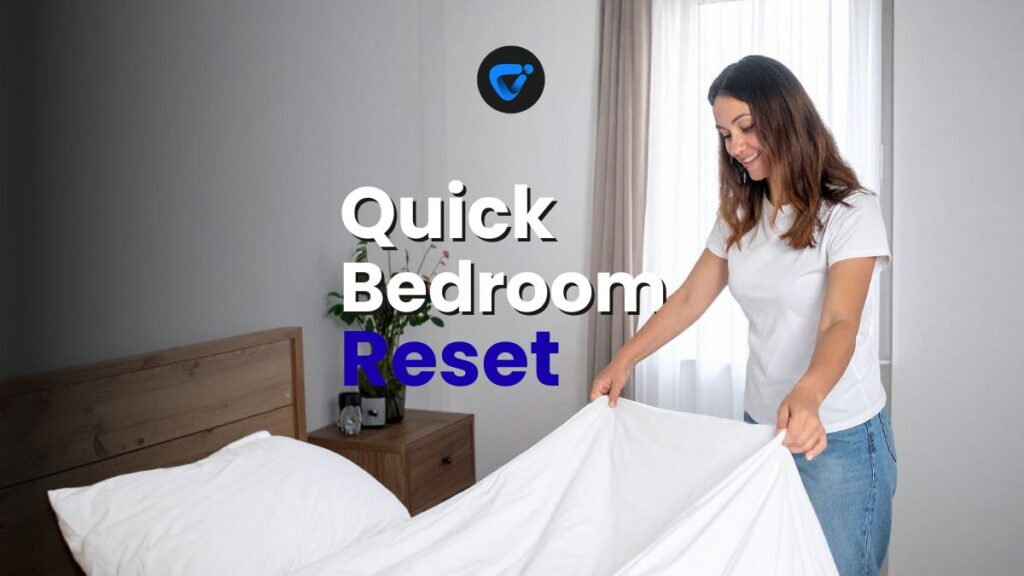
There’s a reliable comfort in coming home to a bedroom that looks and feels refreshed. Even when the rest of the house feels a bit unruly, seeing your sanctuary reset by mid-evening quietly boosts motivation. Taking control with a short bedroom reset routine can make rest come easier and set the stage for a smooth tomorrow.

Simple Lubrication Tips for Sliding Doors
Keep doors gliding smoothly! Follow these simple lubrication tips to fix sticking sliding doors fast. Read on and learn more!
Many find their bedroom becomes a catch-all for life’s clutter, clothing, tech, and day-to-day items. When this space isn’t reset regularly, disorder sticks around and accumulates before you realize it. The good news is that investing 15 minutes into a focused bedroom reset prevents overwhelm and leaves your space genuinely restful.
This guide walks through a practical, minute-by-minute approach for a daily bedroom reset. You’ll see digestible steps, tangible checklists, and even realistic scripts to help you build an effortless daily routine. Let’s quickly turn tidying from a chore into a small moment of control and calm.
Establishing a 15-Minute Routine for Reliable Results
Choose a dependable time each day to start your bedroom reset—such as before work or right before winding down in the evening. This simple timing decision grounds the habit and prevents procrastination-induced stress.
Setting out your tools—a small basket for misplaced items, a duster, and a spray bottle—saves you precious minutes hunting things down. Keeping essentials nearby makes every reset feel easy to begin and finish efficiently.
Daily Cues That Kick-Start Reset Momentum
Some people connect their bedroom reset with a specific signal, such as turning on a calming playlist or opening a window for fresh air. This cue quietly tells your mind, “it’s time to restore.” Repeating a cue builds momentum over time.
Consider stacking the reset with another habit you never miss—like just after brushing your teeth. Habit stacking can help the bedroom reset feel less disruptive and more automatic, even on tired days.
Using body language such as rolling your shoulders back and standing tall signals commitment. Visual reminders like a checklist next to your lamp also support consistency in forming this quick daily ritual.
Breaking It Down: The Five-Minute Micro-Tasks
Begin with five minutes tackling surfaces: make your bed, fluff pillows, and fold stray clothes. These visible wins boost motivation for the next micro-task. During a bedroom reset, redirect any items that belong outside the room straight into your basket for later sorting.
In the next five minutes, wipe down commonly touched areas—doorknobs, nightstands, and light switches. This tiny cleaning habit removes invisible dirt and gently signals that your space is ready for sleep.
The final five minutes focus on the floor. Sweep, vacuum, or collect anything misplaced. Wrapping up by opening the window invites in fresh air—an effortless step that transforms the feel of your entire room.
| Task | Time Needed | Supplies | Actionable Takeaway |
|---|---|---|---|
| Bed Making | 2 min | Pillow, Comforter | Pull tight, smooth sheets—instantly tidy visual focus |
| Declutter Surfaces | 3 min | Basket, Trash Bag | Gather everything non-essential; reset your nightstand |
| Clean Touchpoints | 3 min | Microfiber, Spray | Wipe key spots to cut down germs and dust |
| Floor Check | 4 min | Broom or Vacuum | Clear stray items and any visible debris |
| Final Touch | 3 min | Window or Room Spray | Freshen air or scent as a reset finishing cue |
Clutter Control Strategies That Keep Chaos at Bay
Defining clear boundaries for what belongs in the bedroom and what doesn’t prevents clutter from sneaking in. A bedroom reset should force quick “yes or no” decisions about each item’s place.
Try a system where you immediately move objects that create visual noise—like mugs, receipts, or unfolded laundry—out of sight and out of mind. Using baskets or trays ensures nothing piles up where it shouldn’t.
Simple Rules for Managing Incoming Items
If you carry items into your room during the day, enforce a one-minute “put away” rule. For example, if you bring in a book, return it to your bag or shelf before you leave the room again.
- Designate a drop zone for keys and tech to avoid the “endless search” problem. Label the area or use a tray for immediate recognition.
- Sort clothing into three piles—keep, wash, or store—every night, so nothing lingers on the floor or foot of the bed.
- Clear nightstands entirely except for one or two essentials (book, lamp). Everything else moves to a drawer or another room.
- Address trash daily; add a small bin near your door and empty it each reset to prevent overflow.
- Immediately corral unused chargers and cords in a pouch—messy wires build visual stress fast and undermine relaxation.
This managed approach shrinks daily clutter and gives your bedroom reset a logical rhythm you can actually stick with.
Weekly Mini-Declutter: Going a Step Further
Once a week, add a power declutter session during your bedroom reset. Tackle drawers or wardrobe shelves for five minutes, choosing one type of item—like socks or papers—each time. Remove, sort, and re-home duplicates or items you don’t actually use.
- Set a timer for five minutes as you tackle each section, so decision-making doesn’t stall out. Move quickly, respond “keep” or “remove” without second-guessing.
- Group small items like jewelry in shallow containers and label them. It’s faster to locate and return things after each use.
- Recycle or toss random papers and old receipts from drawers. Keep only what you need for the week ahead in a clear envelope or folder.
- Relocate out-of-season items to a separate shelf or under-bed organizer. This keeps your everyday zone manageable and clutter-free.
- Adjust as you go: if you consistently move an item during resets, reconsider whether it should simply live elsewhere year-round.
Each mini-session compounds over time, making future resets much quicker and easier to complete, and keeps chaos out of your space.
Habit Loops for Fast, Unthinking Resets
Building a daily bedroom reset into your routine works best when you tie it to an existing habit loop. For instance, coupling it with evening coffee or after dinner makes the process nearly automatic.
Habit Triggers and Visual Cues in Action
Placing a folded duster on your pillow each morning reminds you to refresh the space before bed. Or, try a sticky note on the mirror reading, “Reset for rest.” These cues remove overthinking—when you see the cue, you begin.
Analogous to setting out workout clothes to remind yourself to exercise, these small but visible triggers nudge you into the task without hesitation each day.
A simple audio cue, like playing your favorite song for 10 minutes, creates a start-and-stop signal for your bedroom reset. When the song ends, you’re done.
Keep It Moving: No-Delay Micro-Decisions
Practice making fast, effective choices about objects each time you start a bedroom reset. Picture quickly deciding, “Laundry pile or closet? Trash or drawer?” Pausing leads to second-guessing and delays.
Set a rule for yourself: absolutely no item can linger longer than one minute. If you can put it away or clean it in under sixty seconds, just do it.
This micro-decision habit turns a big decluttering job into a rapid, frictionless part of your day, leaving no time for mess to multiply.
Maintaining Surfaces for Calm and Visual Clarity
Keeping visible spaces tidy during your bedroom reset brings immediate calm and a sense of order. Make surfaces like dressers or nightstands look intentional by limiting them to essential items only.
Try organizing by theme: place a book, reading lamp, and glass of water on the nightstand. Everything else is stored out of view, which makes the reset visually satisfying.
Surface-Wise Tidy-Up Order
Start with the largest, eye-level surface and remove all items. Wipe clean before selectively replacing only what’s truly needed. This sequence amplifies the “after” effect and helps cement the bedroom reset habit.
Handling smaller surfaces last prevents them from collecting random clutter. Use trays or shallow containers for habitually loose items, like jewelry, headphones, or coins, and revisit their contents once a week during your reset.
Apply this quick scan process every evening. You’ll train your eyes to spot and remove new clutter before it even settles in.
Building a Minimal Surface Script
Say out loud, “Only my lamp, journal, and glass stay tonight; all else goes.” Practice quickly putting away anything extra after this claim. Over time, this reset verbiage becomes a natural part of your daily wind-down.
Scenario: You notice a stack of unopened mail and scattered pens. Rather than letting it linger, use this approach: “Mail to the basket, pens to the drawer—done.” Repeat with any new clutter you spot each night.
Relating this to real life, imagine clearing your kitchen counter after every meal. The more you practice returning things each time, the easier it is to keep that counter (and your bedroom) reset with next to no time spent.
Small Adjustments for Energy, Lighting, and Scent
A polished bedroom reset is more than just visual. Optimizing air, light, and scent creates an atmosphere that helps rest return after a hectic day and makes your routine feel rewarding.
Test these quick environmental tweaks before or after cleaning: dimming harsh lights, switching to warm bulbs, or using a subtle room spray at the end of your reset.
- Open windows for five minutes as you finish your routine. This brings in fresh air and keeps the space from feeling stuffy, especially useful before sleep.
- Set out fresh linens or a lavender sachet once a week as a small sensory reward for keeping up your bedroom reset. The pleasant scent signals accomplishment and care.
- Keep a small, low-light plant near your bed. This adds a natural visual reset, encourages relaxation, and reminds you that the space is intentionally cared for by you.
- Lower the temperature slightly just before bed. Studies show a cooler room helps sleep come more easily and leaves the air feeling crisp after your reset is finished.
- Add a soft lamp or battery-powered fairy lights for a gentle ambiance that doesn’t disturb your reset or urge to wind down. It’s the lighting equivalent of a “clean slate.”
These finishing touches are fast but impactful, helping you look forward to the nightly routine instead of rushing through it or skipping altogether. Customizing your bedroom reset this way keeps things fresh and effective.
Adapting the Routine for Roommates, Family, or Shared Spaces
When you share a bedroom, communication is the foundation for a successful daily bedroom reset. Setting expectations about when, how, and what needs resetting prevents friction and confusion.
Delegating quick roles—one person makes the bed, while another clears surfaces—cuts reset time in half and supports mutual responsibility. Rotate these mini-roles for fairness and to keep things interesting.
“Let’s Reset” Mini-Routine for Two
Try this out loud: “Ready to reset?” With a simple timer, both parties swap rooms for three minutes and tidy what’s not theirs—mutual respect is baked right in. This habit promotes accountability and daily collaboration without awkward reminders.
Use a shared checklist to clarify responsibilities: Who empties the trash? Who dusts? Who puts away laundry? Visual lists lower the nag factor by making the reset process visible and predictable.
When tight schedules make resets tricky, anchor tasks to when you’re both there (say, after breakfast or just before leaving for work) for fewer missed days and less resentment over uneven effort.
Kid-Friendly Steps for a Family Bedroom Reset
Kids thrive with visual cues and simple scripts. For example: “Teddy on bed, books on shelf, pajamas in hamper.” Celebrate quick wins each evening to make the routine positive rather than a chore to be avoided.
Designate bins or baskets by color or name so children know where everything lives—not just for tidying, but for everyday routines, too.
Let kids choose a fun reset soundtrack. Pausing the song signals that reset time is over. This keeps the activity short, structured, and engaging while establishing lifelong bedroom reset habits for everyone.
Closing Out: Making the Bedroom Reset an Unstoppable Habit
Sticking to a fifteen-minute bedroom reset enhances sleep, saves time later, and keeps disorder manageable. Practice makes each reset a little faster—and eventually, a natural part of your daily rhythm.
Even during the busiest weeks, showing up for this routine pays off. The space you rest in becomes a tiny pocket of calm and control. That feeling is motivating in itself and worth maintaining with a quick daily reset.
Let your bedroom reset be an act of self-care, not just another task. Each evening, you reclaim a small sanctuary, setting yourself up for quality rest and less overwhelmed mornings. Embrace it as a simple win, every single day.
Frequently Asked Questions
Work in set five-minute blocks: surfaces first, then floor, then details. Set a timer, use a basket for stray items, and make your bed every time. These steps streamline the reset and boost consistency.
Absolutely. Set clear boundaries for personal items, delegate reset roles when possible, and use checklists. Regularly placing belongings in designated baskets or bins keeps even tight quarters feeling tidy daily.
Limit surface items to true essentials, then do a nightly scan and put away anything new. Use shallow trays or containers to corral small items, and revisit what stays out every week to prevent buildup.
Don’t stress—just resume your bedroom reset where you left off. Restarting is much faster after only a couple missed days versus letting clutter build for a whole week or more.
Communicate expectations clearly, share short checklists, rotate tasks for fairness, and keep the routine short. Mini rewards or favorite music can motivate others and help the habit stick as a team effort over time.

DIY Patching for Small Drywall Holes at Home
Fix wall damage fast! Follow our DIY guide to patch small drywall holes easily and get smooth, lasting results.


